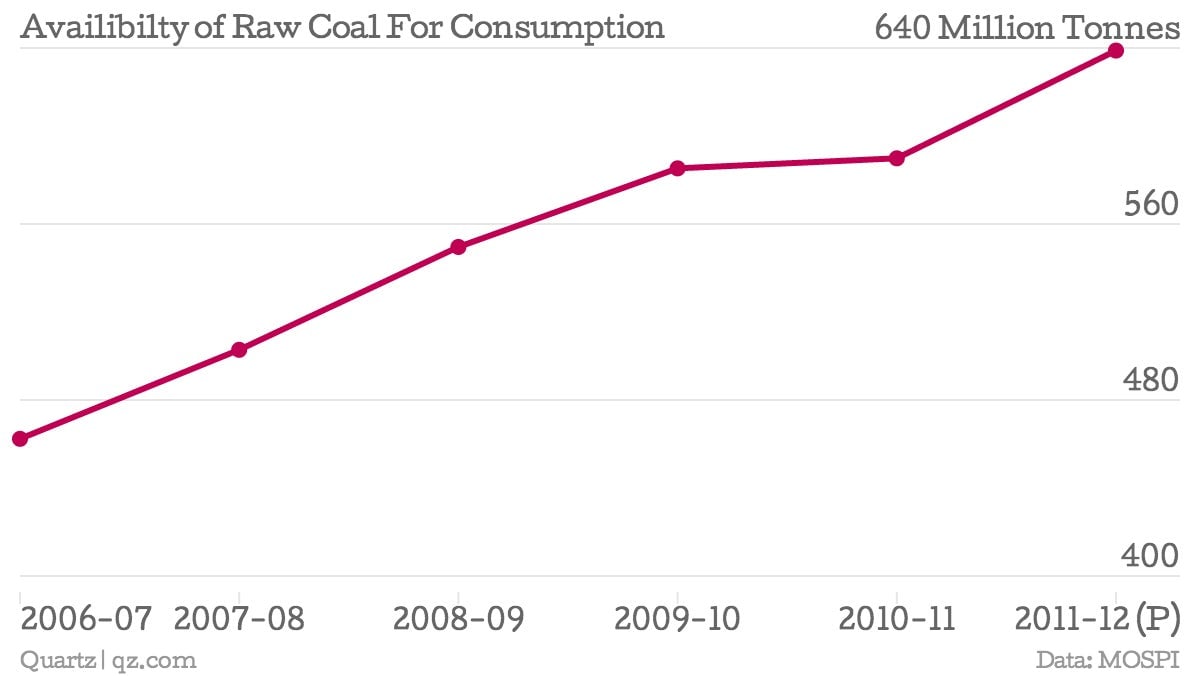How to fix India’s crippling coal shortage in four easy steps
India is trying to add 15-20 gigawatts of power generation capacity every year. Meeting this target is key to reviving rapid economic growth. It is critical from a social perspective as well, as it promises to extend coverage to over 350 million Indians currently without access to electricity.


India is trying to add 15-20 gigawatts of power generation capacity every year. Meeting this target is key to reviving rapid economic growth. It is critical from a social perspective as well, as it promises to extend coverage to over 350 million Indians currently without access to electricity.
Considering the target consumers, it is important that power is generated affordably. This limits fuel options. Price of gas produced domestically is in for a major revision that will make gas-based power generation expensive. Besides, being denominated in US dollars, the price of gas is vulnerable to forex variations. This leaves coal as the mainstay in the primary energy scenario for the foreseeable future.
Reversing the current growth rate of around 3% in coal production annually to a compounded annual growth rate of 10% over a longer term of a decade is therefore imperative to accelerate power generation and move the economy to a sustained higher growth orbit. The following are some of the key measures to take us there.
- Rethink the Environment vs Mining debate.
- Allow entry of formidable mining companies to create competition in the coal sector.
- Implement pending rail projects in mining areas to enhance coal evacuation capacity.
- Introduce coal beneficiation, or separation into better quality, on a large scale to cover all coal that is not consumed at pithead power stations.
Let us examine some of these more closely.
A responsive coal mining industry committed to social and environmental sustainability can surely work in cohesion with pragmatic environment regulators and bridge the huge trust deficit that exists at present. This holds the key to faster environment and forest clearance. A beginning in this direction was made by Coal India Ltd in 2008 when it implemented surveillance of land restoration and reclamation of major opencast mines through satellite imagery and reported the findings in its website. As a result, 53 large mines secured ISO 14001 certification in the course of a year and CIL achieved its highest production growth of 6.8% in 2009-10. However, the blanket ban on industrial expansion in critically polluted zones introduced by the ministry of environment and forests (MoEF) in 2010-11 wiped out the growth rate in coal production to near zero. This clearly indicates the need for closer coordination between mining community and environment regulators to uphold the interest of the country instead of only pursuing their respective agenda.

Ideally, in the existing mines, the environment ministry should concern itself with restricting the pollution load within permissible limits rather than setting limit for coal production. The pollution load can be contained within limits even at higher levels of production by adding more pollution mitigating equipment such as water sprinklers. The coal mines should be encouraged to do so and in return, allowed to produce more coal. If mines are found to be exceeding the pollution limit, stringent penalties must be imposed. For critically polluted industrial clusters, ban on expansion should be enforced selectively on the industries responsible for causing critical pollution. A blanket ban on industrial activity is not an optimal solution.
In the area of forest clearance, the process as well as the norms should be simplified for low density forests with a built-in provision for deemed approval after 300 days from submission of valid application. For the so-called open forests, which means it is a forest only on paper, the procedure should be drastically simplified and forest clearance conveyed within a time frame of 90 days. No such clearance should be mandatory for drilling holes for exploration in forest areas as the area of intervention is a meagre 0.5%. Agreeing in principle to this suggestion in 2009, former environment minister Jairam Ramesh had allowed exploration in 3 forest blocks and the outcome has convincingly established the merit of this idea.
To allow the entry of formidable players with core competence in coal mining, we need to repeal the Coal Mines Nationalization Act. The previous NDA government had prepared a bill for this. It is still pending. The factors that deterred its passage back then are no longer relevant. Once repealed, the coal blocks should be bundled into blocks of say 5 billion tonnes each through merger of unallotted or cancelled blocks. These should then be distributed through a transparent process for exploration followed by mining to large coal mining companies with proven competence. Coal India Ltd should continue as a strong domestic player to create a balance. Soon an atmosphere of competition will emerge that will not only sustain higher growth rate in coal production but also bring in the global best practices and technology infusion, particularly for underground mining.
Since majority of coal will continue to be produced by opencast mining with drilling & blasting operations, coal quality will continue to be a thorny issue unless coal washing is adopted on a large scale. Recent MoEF guidelines require coal moving beyond 500 kms for power generation to have ash not exceeding 34% from Jan 2016. The average distance of coal movement being around 600 kms, it is safe to assume that around 60% of coal may need washing. This will also improve the efficiency of transport as lesser ash would be transported.
Evacuation capacity in the form of rail linkages must be upgraded in tandem with increase in production. The pending rail projects in Jharkhand, Orissa & Chhattisgarh needs fast track implementation.
Concerted efforts on all these areas can transform the current coal shortage scenario into abundance in a span of 5 to 7 years.